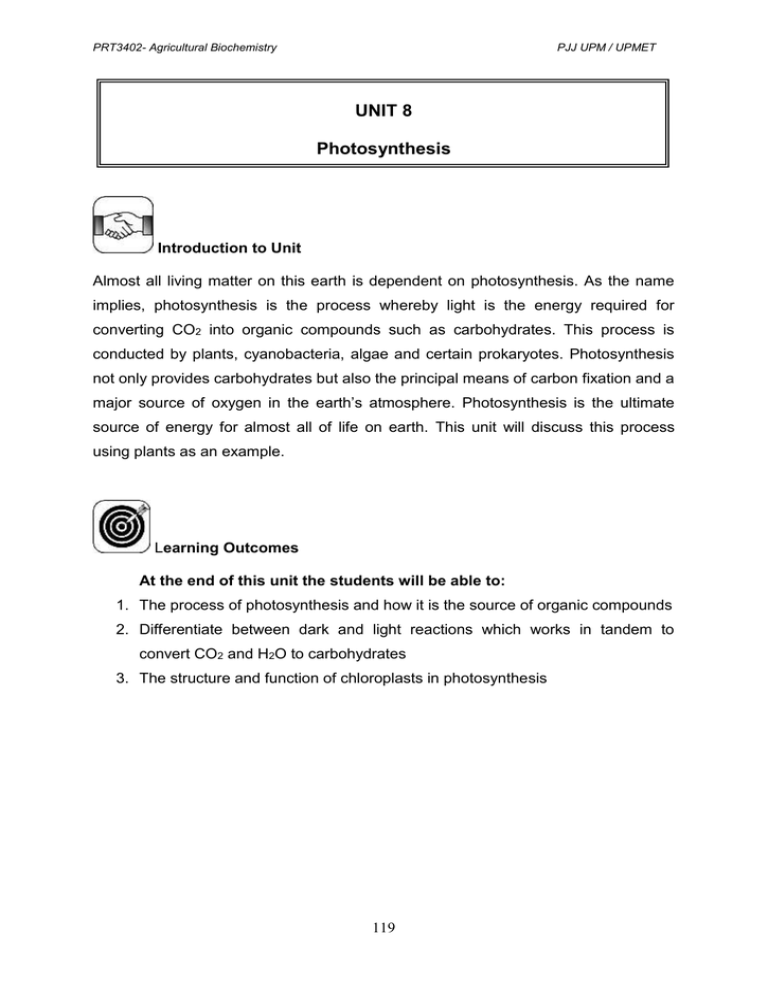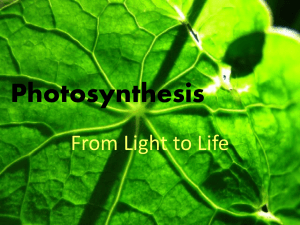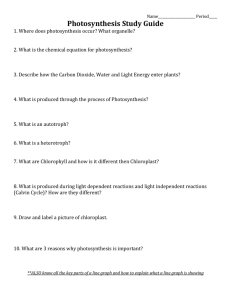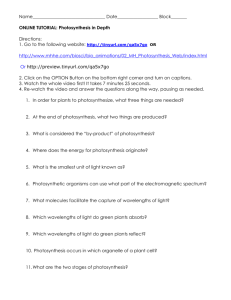Photosynthesis
advertisement

PRT3402- Agricultural Biochemistry PJJ UPM / UPMET UNIT 8 Photosynthesis Introduction to Unit Almost all living matter on this earth is dependent on photosynthesis. As the name implies, photosynthesis is the process whereby light is the energy required for converting CO2 into organic compounds such as carbohydrates. This process is conducted by plants, cyanobacteria, algae and certain prokaryotes. Photosynthesis not only provides carbohydrates but also the principal means of carbon fixation and a major source of oxygen in the earth’s atmosphere. Photosynthesis is the ultimate source of energy for almost all of life on earth. This unit will discuss this process using plants as an example. Learning Outcomes At the end of this unit the students will be able to: 1. The process of photosynthesis and how it is the source of organic compounds 2. Differentiate between dark and light reactions which works in tandem to convert CO2 and H2O to carbohydrates 3. The structure and function of chloroplasts in photosynthesis 119 PRT3402- Agricultural Biochemistry PJJ UPM / UPMET TOPIC 1 : Light and leaf Main Points 1.1 Photosynthesis is the process by which living organisms harvest the energy of the sun to reduce CO2 and H2O to energy-rich carbohydrates. As reduction involves adding electrons to molecules it is therefore an endergonic process which will requires energy. This energy comes from the sunlight. A simplistic reaction of photosynthesis is: 1.2 The reaction above is endergonic, an enormous amount of energy (ΔGo = +2870 kJ/mol) is required which is provided by light. It is an oxidation-reduction reaction in which the oxidizing agent CO2 will be reduced to C6H12O6 and H2O as reducing agent will be oxidized to O2. 1.3 Plants, algae, cyanobacteria and photosynthetic bacteria are capable of photosynthesis. Other organisms, like us, rely on the carbohydrates produced by photosynthesis as our source of energy when we consumed them. Photosynthetic organisms are the producer for our energy source. 1.4 Light is a physical entity made of electromagnetic waves and quantum ‘packets of energy’ known as photons. Light waves always travel at the same speed in a vacuum. The wavelength determines the amount of energy carried by 120 PRT3402- Agricultural Biochemistry each photon. PJJ UPM / UPMET Light waves have different wavelengths in a spectrum from gamma rays (most energetic, shortest) to radio waves (least energetic, longest), only a portion of which are visible. 1.5 Photosynthetic organisms are green because the pigment chlorophyll absorbs only certain wavelengths of light (mostly red and blue). The wavelengths it does not absorb are radiated back to our eyes and, collectively, this appears green to our eyes. The spectrum of light and the portion that is absorbed by chlorophyll is shown below. 1.6 Taking the plants as an example, the leaves are well suited structurally to harvest light for photosynthesis. In the leaves, localized organelles are present just under the leaf surface (mesophyll cells). Within the mesophyll cells, chloroplasts are present which is similar to mitochondria. The inner membrane of the chloroplast encloses the stroma and immersed in the stroma are flat, sac-like membrane structures called thylakoids. Thylakoids are stacked to form units of grana. Individual grana are irregularly interconnected by thylakoid extension 121 PRT3402- Agricultural Biochemistry PJJ UPM / UPMET called stroma lamellae. The thylakoid membrane encloses an interior space, lumen of the thylakoid. 1.7 The division of labour within chloroplast is such that absorption of light and all light reactions occur within or on the thylakoid membrane. The ATP and NADPH produced by these reactions are released in the surrounding stroma where all the synthetic dark reactions take place. 1.8 Details of the structure of a unit of granum is shown below. 122 PRT3402- Agricultural Biochemistry 1.19 PJJ UPM / UPMET The chloroplast and its content are shown below Answers to Exercise 1 Answers to Group Exercise / Discussion 123 PRT3402- Agricultural Biochemistry PJJ UPM / UPMET TOPIC 2; LIGHT DEPENDENT AND LIGHT INDEPENDENT (DARK) REACTIONS Main Points 2.1 Photosynthesis begins in the thylakoid membranes which have the chlorophyll molecules on photosystem. Photosynthesis ends in the stroma (with starch). The stroma surrounds the thylakoids which is enclosed by the double membrane of the chloroplast. 2.2 Photosynthesis occurs in two phases – light dependent reaction and light independent (dark) reaction. The following sequence of events takes place during the light dependent phase: Step 1: Chlorophyll absorbs a photon at Photosystem II and one of its electrons is kicked off onto an electron carrier molecule. Step 2: Now lacking an electron, chlorophyll grabs one from a water molecule in the stroma, splitting the water into H+ and O2. Step 3: The O2 diffuses out of the cell and is expired by the plant. Step 4: H+ begins to build up in the stroma. Step 5: The electron carrier molecule now transfers the electron it received from chlorophyll down a transport chain, similar to that in the mitochondrion. Step 6: At each step, the energy released by the transport of the electrons is use to pump H+ ions against their gradient into the stroma. This process produces an H+ gradient, with much higher concentrations of H+ inside the stroma than outside. Step 7: The H+ ions flow out of the stroma with their concentration gradient through an ATP synthase enzyme pore, driving the production of ATP from ADP + P. 124 PRT3402- Agricultural Biochemistry PJJ UPM / UPMET 125 PRT3402- Agricultural Biochemistry PJJ UPM / UPMET Step 8: At the end of the electron transport chain, the electrons are dumped onto a second set of chlorophyll molecules at Photosystem I. Step 9: Light hits these chlorophyll molecules and kicks the electrons off them onto electron carriers. Step 10: The electrons are passed down a second electron transport chain and are finally dumped onto NADP to form NADPH, a molecule that will carry electrons and hydrogens to the Light Independent (starch-building phase) of photosynthesis. 126 PRT3402- Agricultural Biochemistry PJJ UPM / UPMET 127 PRT3402- Agricultural Biochemistry 2.3 PJJ UPM / UPMET ATP and NADPH produced in the light dependent phase is then transferred to the light independent reactions in the stroma. 2.4 Light-independent (or dark) reaction is the second phase of the photosynthesis. ATP and NADPH are not good permanent storage molecules, so the plants convert the energy into carbohydrates. Electrons from carriers are added to CO2 (“breathed in” by the plant) and H2O to reduce these molecules to starch. Reactions occur in the stroma of the thylakoid. The main cycle of reactions is called the Calvin Cycle. 2.5 The relationship between photosynthesis and oxidative respiration is indicated below. 2.6 The diagram below summarizes the process of photosynthesis. 128




